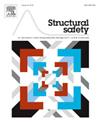A probabilistic framework to construct tropical cyclone loss models for building portfolios
IF 6.3
1区 工程技术
Q1 ENGINEERING, CIVIL
引用次数: 0
Abstract
Tropical cyclones (TCs) evolve over time and space and can cause substantial damage to building portfolios. Therefore, timely and accurate TC damage assessment is essential for effective risk management. One practical approach is to establish a relationship between hazard intensity (e.g., wind speeds) and regional damage. However, when the study area is large, spatial heterogeneity, such as clustered building distributions, terrain variability, and spatial variations in wind speeds, can hinder accurate modelling of the hazard-damage relationship. To address this challenge, the present study employs a spatial clustering algorithm to divide the entire area into multiple sub-regions with relatively homogeneous characteristics. For each sub-region, a TC loss model is developed as a function of wind speed at the sub-regional centroid and the corresponding building portfolio loss ratio. In practice, losses in all sub-regions are first assessed individually and then aggregated to estimate the total regional loss. This divide-and-aggregate approach significantly improves the accuracy and applicability of TC loss modelling and can be readily applied to various contexts, such as long-term risk management in large-scale communities.
为建筑投资组合构建热带气旋损失模型的概率框架
热带气旋(tc)随着时间和空间的变化而演变,并可能对建筑组合造成重大损害。因此,及时准确地评估TC损伤对有效的风险管理至关重要。一种实际的方法是建立灾害强度(如风速)和区域损害之间的关系。然而,当研究区域较大时,空间异质性,如集群建筑分布、地形变异性和风速的空间变化,可能会阻碍对灾害-损害关系的准确建模。为了解决这一挑战,本研究采用空间聚类算法将整个区域划分为多个具有相对均匀特征的子区域。对于每个子区域,建立了以子区域质心风速和相应建筑组合损失率为函数的TC损失模型。在实践中,首先对所有分区域的损失进行单独评估,然后汇总估算区域损失总额。这种划分和汇总方法显著提高了TC损失模型的准确性和适用性,可以很容易地应用于各种情况,例如大规模社区的长期风险管理。
本文章由计算机程序翻译,如有差异,请以英文原文为准。
求助全文
约1分钟内获得全文
求助全文
来源期刊

Structural Safety
工程技术-工程:土木
CiteScore
11.30
自引率
8.60%
发文量
67
审稿时长
53 days
期刊介绍:
Structural Safety is an international journal devoted to integrated risk assessment for a wide range of constructed facilities such as buildings, bridges, earth structures, offshore facilities, dams, lifelines and nuclear structural systems. Its purpose is to foster communication about risk and reliability among technical disciplines involved in design and construction, and to enhance the use of risk management in the constructed environment
 求助内容:
求助内容: 应助结果提醒方式:
应助结果提醒方式:


